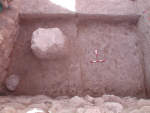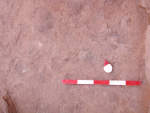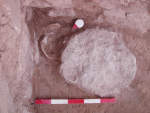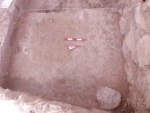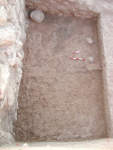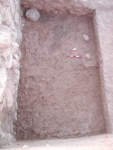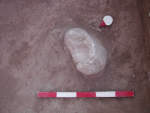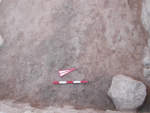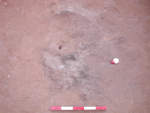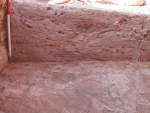1. OVERVIEW
| Roster | Date | Author | Record |
|---|---|---|---|
| Included in other label | 2010-12-03 | cJC | ^use1 (use area) [Input: T914CJC.j] |
| Category | !! | !! | buildup |
| Best definition | 2005-08-14 | mH | accumulation B [Input: P912MH.j] |
| Summary | 2007-07-13 | pC | f171 is clearly a use area, while plenty of tannur pieces, bone, gypsum pieces and ash was found. About 15-20 down the soil turns more compact and contains even more ash and charcoal. it is the same as f174 (and f183) [Input: S205PC.j] |
| Best image | 2007-07-13 | pC | 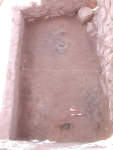 v87 [Input: S205PC.j] |
2. IDENTIFICATION
Designation
| Roster | Date | Author | Record |
|---|---|---|---|
| Description (summary) | 2005-08-14 | mH | gypsum, charcoal [Input: P911MH.j] |
3. STRATIGRAPHY
Recovery/Assignment
| Roster | Date | Author | Record |
|---|---|---|---|
| Argument | 2005-08-16 | mH | After the excavations were stoped in k13 temporarily I had a look at the southern section of the unit, where soil color and texture changes were clearly visible. In the section we can see a gray deposit, which is clearly natural. This we had labeled f140. Underneath that is a browner layer with a crumbly texture. At the time of excavation we labeled this as f171. At first this feature contained plenty of tannur pieces, bone, gypsum pieces and ash. About 15-20 down the soil turns more compact and contains even more ash and charcoal. While excavating these changes were not as pronounced thus we kept the same feature number through this change. The tannur pieces, bone, ash and charcoal all indicate, however, that this feature as a whole was a use area. [Input: P816MH.j] |
Volumetric Localization
| Roster | Date | Author | Record |
|---|---|---|---|
| Locus | 2005-08-14 | mH | k13 [Input: P912MH.j] |
| M#/elev @top | 2005-08-14 | mH | 8898 [Input: P912MH.j] |
| M#/elev @bottom | 2005-08-14 | mH | 8865 [Input: P912MH.j] |
Contact Association
| Roster | Date | Author | Record |
|---|---|---|---|
| Type of contact: latest events | 2005-08-03 | mH | f174 (accumulation B) abuts f171 (accumulation B) [Input: S211PC2.j] |
| 2005-08-03 | mH | f140 (accumulation D) covers f171 (accumulation B) [Input: S211PC2.j] | |
| 2005-08-03 | mH | f176 (accumulation D) overlays f171 (accumulation B) [Input: S211PC2.j] | |
| Type of contact: contemporary events/movable items | 2005-08-15 | sC | i9 (doorsocket) sits in f171 (accumulation B) [Input: P913MH4.j] |
| 2005-08-14 | !! | q455.1 (clay lump) sits in f171 (accumulation B) [Input: P909MH.j] | |
| 2005-08-15 | !! | q487.1 (figurine) sits in f171 (accumulation B) [Input: P909MH.j] | |
| 2005-08-14 | mH | q455 (bones, pottery) sits in f171 (accumulation B) [Input: P909MH.j] | |
| 2005-08-14 | sC | q461 (pottery) sits in f171 (accumulation B) [Input: P909MH.j] | |
| 2005-08-14 | sC | q462 (bones, pottery) sits in f171 (accumulation B) [Input: P909MH.j] | |
| 2005-08-15 | vVE | q480 (items, pottery) sits in f171 (accumulation B) [Input: P909MH.j] | |
| 2005-08-15 | sC | q487 (bones, pottery) sits in f171 (accumulation B) [Input: P909MH.j] | |
| 2005-08-15 | sC | q491 (bones, pottery) sits in f171 (accumulation B) [Input: P909MH.j] | |
| 2005-08-14 | !! | q455-p1 (sq) sits in f171 (accumulation B) [Input: P909MH.j] | |
| 2005-08-14 | !! | q455-p2 (sq) sits in f171 (accumulation B) [Input: P909MH.j] | |
| 2005-08-14 | !! | q455-p3 (jar) sits in f171 (accumulation B) [Input: P909MH.j] | |
| 2005-08-14 | !! | q455-p4 (r) sits in f171 (accumulation B) [Input: P909MH.j] | |
| 2005-08-14 | !! | q455-p5 (sq) sits in f171 (accumulation B) [Input: P909MH.j] | |
| 2005-08-14 | !! | q455-p6 (i) sits in f171 (accumulation B) [Input: P909MH.j] | |
| 2005-08-14 | !! | q455-p7 (jar) sits in f171 (accumulation B) [Input: P909MH.j] | |
| 2005-08-14 | !! | q455-p8 (xdc) sits in f171 (accumulation B) [Input: P909MH.j] | |
| 2005-08-14 | !! | q455-p9 (xfc) sits in f171 (accumulation B) [Input: P909MH.j] | |
| 2005-08-14 | !! | q455-p70 (body sherd) sits in f171 (accumulation B) [Input: P909MH.j] | |
| 2005-08-14 | !! | q455-p71 (body sherd) sits in f171 (accumulation B) [Input: P909MH.j] | |
| 2005-08-14 | !! | q455-p72 (body sherd) sits in f171 (accumulation B) [Input: P909MH.j] | |
| 2005-08-14 | !! | q455-p73 (body sherd) sits in f171 (accumulation B) [Input: P909MH.j] | |
| 2005-08-14 | !! | q455-p74 (body sherd) sits in f171 (accumulation B) [Input: P909MH.j] | |
| 2005-08-14 | !! | q455-p75 (body sherd) sits in f171 (accumulation B) [Input: P909MH.j] | |
| 2005-08-14 | !! | q455-p76 (body sherd) sits in f171 (accumulation B) [Input: P909MH.j] | |
| 2005-08-14 | !! | q461-p70 (body sherd) sits in f171 (accumulation B) [Input: P909MH.j] | |
| 2005-08-14 | !! | q461-p71 (body sherd) sits in f171 (accumulation B) [Input: P909MH.j] | |
| 2005-08-14 | !! | q461-p72 (body sherd) sits in f171 (accumulation B) [Input: P909MH.j] | |
| 2005-08-14 | !! | q461-p73 (body sherd) sits in f171 (accumulation B) [Input: P909MH.j] | |
| 2005-08-14 | !! | q462-p1 (jar) sits in f171 (accumulation B) [Input: P909MH.j] | |
| 2005-08-14 | !! | q462-p2 (jar) sits in f171 (accumulation B) [Input: P909MH.j] | |
| 2005-08-14 | !! | q462-p3 (bowl) sits in f171 (accumulation B) [Input: P909MH.j] | |
| 2005-08-14 | !! | q462-p4 (sq) sits in f171 (accumulation B) [Input: P909MH.j] | |
| 2005-08-14 | !! | q462-p5 (xfc) sits in f171 (accumulation B) [Input: P909MH.j] | |
| 2005-08-14 | !! | q462-p6 (xdc) sits in f171 (accumulation B) [Input: P909MH.j] | |
| 2005-08-14 | !! | q462-p7 (xfc) sits in f171 (accumulation B) [Input: P909MH.j] | |
| 2005-08-14 | !! | q462-p8 (xlf) sits in f171 (accumulation B) [Input: P909MH.j] | |
| 2005-08-14 | !! | q462-p74 (body sherd) sits in f171 (accumulation B) [Input: P909MH.j] | |
| 2005-08-14 | !! | q462-p75 (body sherd) sits in f171 (accumulation B) [Input: P909MH.j] | |
| 2005-08-14 | !! | q462-p76 (body sherd) sits in f171 (accumulation B) [Input: P909MH.j] | |
| 2005-08-14 | !! | q462-p77 (body sherd) sits in f171 (accumulation B) [Input: P909MH.j] | |
| 2005-08-14 | !! | q462-p78 (body sherd) sits in f171 (accumulation B) [Input: P909MH.j] | |
| 2005-08-14 | !! | q462-p79 (body sherd) sits in f171 (accumulation B) [Input: P909MH.j] | |
| 2005-08-14 | !! | q462-p80 (body sherd) sits in f171 (accumulation B) [Input: P909MH.j] | |
| 2005-08-14 | !! | q462-p81 (body sherd) sits in f171 (accumulation B) [Input: P909MH.j] | |
| 2005-08-14 | !! | q462-p82 (body sherd) sits in f171 (accumulation B) [Input: P909MH.j] | |
| 2005-08-15 | !! | q480-p1 (bowl) sits in f171 (accumulation B) [Input: P909MH.j] | |
| 2005-08-15 | !! | q480-p2 (xsc) sits in f171 (accumulation B) [Input: P909MH.j] | |
| 2005-08-15 | !! | q480-p3 (bowl) sits in f171 (accumulation B) [Input: P909MH.j] | |
| 2005-08-15 | !! | q480-p4 (jar) sits in f171 (accumulation B) [Input: P909MH.j] | |
| 2005-08-15 | !! | q480-p5 (bowl) sits in f171 (accumulation B) [Input: P909MH.j] | |
| 2005-08-15 | !! | q480-p6 (r) sits in f171 (accumulation B) [Input: P909MH.j] | |
| 2005-08-15 | !! | q480-p70 (body sherd) sits in f171 (accumulation B) [Input: P909MH.j] | |
| 2005-08-15 | !! | q480-p71 (body sherd) sits in f171 (accumulation B) [Input: P909MH.j] | |
| 2005-08-15 | !! | q480-p72 (body sherd) sits in f171 (accumulation B) [Input: P909MH.j] | |
| 2005-08-15 | !! | q480-p73 (body sherd) sits in f171 (accumulation B) [Input: P909MH.j] | |
| 2005-08-15 | !! | q480-p74 (body sherd) sits in f171 (accumulation B) [Input: P909MH.j] | |
| 2005-08-15 | !! | q487-p1 (jar) sits in f171 (accumulation B) [Input: P909MH.j] | |
| 2005-08-15 | !! | q487-p2 (xfx) sits in f171 (accumulation B) [Input: P909MH.j] | |
| 2005-08-15 | !! | q487-p3 (bowl) sits in f171 (accumulation B) [Input: P909MH.j] | |
| 2005-08-15 | !! | q487-p4 (bowl) sits in f171 (accumulation B) [Input: P909MH.j] | |
| 2005-08-15 | !! | q487-p5 (xfx) sits in f171 (accumulation B) [Input: P909MH.j] | |
| 2005-08-15 | !! | q487-p6 (i) sits in f171 (accumulation B) [Input: P909MH.j] | |
| 2005-08-15 | !! | q487-p7 (jar) sits in f171 (accumulation B) [Input: P909MH.j] | |
| 2005-08-15 | !! | q487-p8 (cup) sits in f171 (accumulation B) [Input: P909MH.j] | |
| 2005-08-15 | !! | q487-p9 (cup) sits in f171 (accumulation B) [Input: P909MH.j] | |
| 2005-08-15 | !! | q487-p10 (r) sits in f171 (accumulation B) [Input: P909MH.j] | |
| 2005-08-15 | !! | q487-p11 (jar) sits in f171 (accumulation B) [Input: P909MH.j] | |
| 2005-08-15 | !! | q487-p70 (body sherd) sits in f171 (accumulation B) [Input: P909MH.j] | |
| 2005-08-15 | !! | q487-p71 (body sherd) sits in f171 (accumulation B) [Input: P909MH.j] | |
| 2005-08-15 | !! | q487-p72 (body sherd) sits in f171 (accumulation B) [Input: P909MH.j] | |
| 2005-08-15 | !! | q487-p73 (body sherd) sits in f171 (accumulation B) [Input: P909MH.j] | |
| 2005-08-15 | !! | q487-p74 (body sherd) sits in f171 (accumulation B) [Input: P909MH.j] | |
| 2005-08-15 | !! | q487-p75 (body sherd) sits in f171 (accumulation B) [Input: P909MH.j] | |
| Type of contact: earliest events | 2005-08-03 | mH | f171 (accumulation B) abuts f127 (wall) [Input: S211PC2.j] |
| 2005-08-03 | mH | f171 (accumulation B) abuts f128 (wall) [Input: S211PC2.j] | |
| 2005-08-03 | mH | f171 (accumulation B) covers f183 (accumulation B) [Input: S211PC2.j] | |
| Ceramic typological distribution | !! | !! | frequencies of ceramic vessels and sherds included within feature |
Spatial Aggregation
| Roster | Date | Author | Record |
|---|---|---|---|
| Aggregate (to which element belongs) | 2007-07-18 | pC | a6 (installation) [Input: S206PC2.j] |
Time Sequencing
| Roster | Date | Author | Record |
|---|---|---|---|
| Stratum (to which element belongs) | 2011-11-11 | cJC | s176J2B [Input: VY11CJC.j] |
| Phase (to which element belongs) | 2011-11-11 | !! | h7fJ2B [Input: VY11CJC.j] |
| Stratigraphic reasons of assignment | 2008-03-05 | pC | use area equal to f174, f150 [Input: S305PC.j] |
| Typological reasons for assignment | 2005-09-14 | mH | Mixed pottery [Input: S215PC.j] |
| Other reasons, reservations, qualifications | 2005-09-14 | mH | Same in elevation as f150 in k4. Also same as f174 in k104. [Input: S215PC.j] |
| 2011-05-16 | cJC | Equal to f150 [Input: V516CJC.j] | |
| 2011-11-21 | cJC | Includes mixed EDIII and Mittani sherds. Uppermost levels of EDIII accumulation before covered with Mittani debris. It is unclear which Mittani stratum this feature belongs to. It is at roughly the equivalent elevation as the post-brickfall use (similar to f174), but it would have already been high in the EDIII period, meaning that if it is part of post-brickfall use, there is no build-up during the pre-brickfall Mittani or during the brickfall phase. It may be that this area close to the revetment wall was kept clean and protected from build-up by the construction of the Mittani curtain wall (f288). [Input: VY21CJC.j] | |
| Notes on time sequencing | 2005-09-12 | mKB | this feature is stratigraphically equal to f174 in the column. Ceramics in it include 1 disk base and 1 small footed base both probably Mitani,1 double rim necked jar from the Khabur period. Earlier ceramics date from Phase h1JPA and include an S ware bowl rim and slightly convex base, a string cut base with bitumen inside that is thick and probably contained bitumen being applied elsewhere as opposed to a bitumen coating on this cup itself. This feature is mixed containing both late material (Phase h6JPA and posible 5) and Phase h1JPA, so the feature is transitional in the sense that it is the interface between these phases but not transitional in the sense of a gradual change through time from one phase to the next. [Input: P912MKB.j] |
4. TYPOLOGY
Morphology
| Roster | Date | Author | Record |
|---|---|---|---|
| Texture, surface finish | 2005-08-14 | mH | fine [Input: P912MH.j] |
6. REFERENCE
Analogical Record
| Roster | Date | Author | Record |
|---|---|---|---|
| View/drawing of features | |||
Disposition
| Roster | Date | Author | Record |
|---|---|---|---|
| Removed (feature), discarded/missing (item) | 2005-08-14 | mH | P816 [Input: P912MH.j] |
